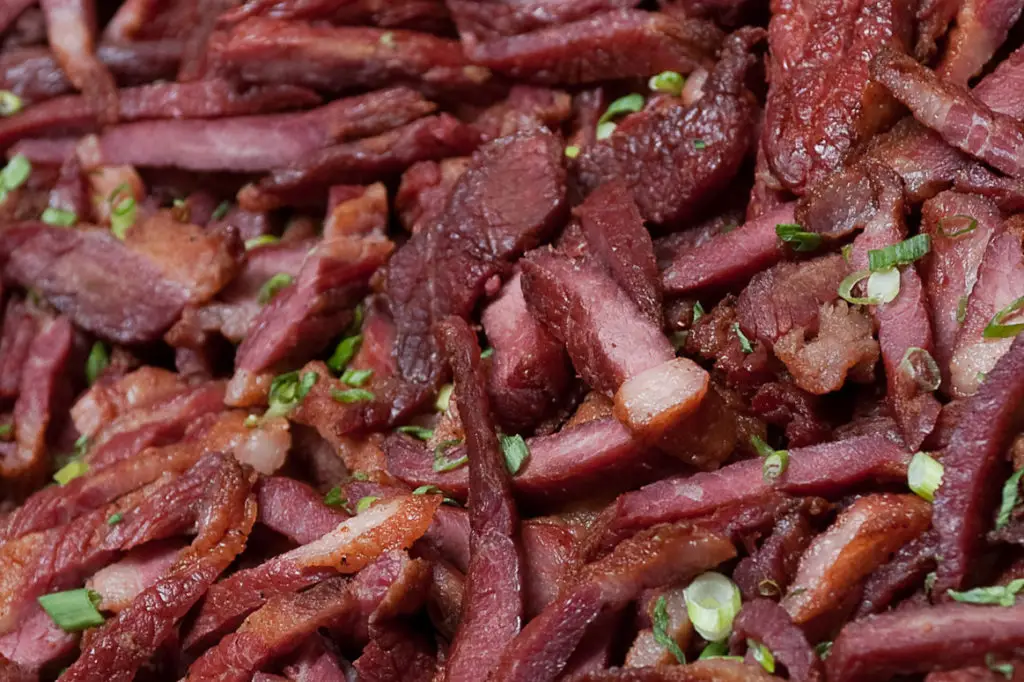Tinala’ Katne: Dried Beef

Table of Contents
Share This
Description
Cured and dried strips of beef.
History
Origin
The Spanish introduced cattle to the Mariana Islands after establishing settlements in the 17th century. Prior to Spanish arrival CHamoru diet consisted of seafood and roots and tubers such as taro and yams, breadfruit and bananas.
Historical documents state that CHamorus preferred fish to meat, but over time with Spanish colonization this changed. French Priest Charles Le Gobien wrote of the diet changes referring to the time period of the late 1600s and early 1700s:
From this time on, the Mariana Islanders began to acquire the customs of the Spaniards and to conform with their usages. They were taught to cover themselves and to make their clothes, to sow Indian corn, to make bread and to eat meat.
Spanish administrators tried to raise cattle to create a commercial industry in the islands, but it never flourished. The cattle were described as being similar to Jersey cows in appearance, but smaller and they did not produce large amounts of milk. Eventually, several wild cattle were found in the neighboring island of Tinian, likely survivors of a ship wreck.
Beef also has an interesting place in CHamoru history. In 1742, during British Admiral Lord George Anson’s famed voyage around the world, the expedition landed in Tinian and happened upon a CHamoru hunting party. Hunters made regular trips to the island for cattle and pigs that populated the island. The meat would be dried and shipped back to Guam to feed the Spanish military. Anson captured the nearly two dozen CHamorus, a Spanish officer, a small Spanish sailing boat and a CHamoru proa. Anson’s expedition led one of the earliest detailed written accounts and drawings of the design and mechanics of the proa that fascinated the early Europeans for its speed and maneuverability.
Evolution
Drying foods is a centuries-old method of preserving food practiced throughout the world. In the Marianas, ancient CHamorus dried and salted fish, preserved breadfruit by soaking it in saltwater before burying the fruit, or cut it into slices and dried it in the sun. This food preservation method was used with the introduction of beef into the CHamoru diet and was necessary as refrigerators were not common in CHamoru households until the mid- to late-1950s and 1960s.
Beef is now a common dish on CHamoru fiesta tables. Traditionally, men slaughtered cows for special occasions or to just feed families. After slaughter, meat was butchered and pieces were doled out to different families. Cattle ownership became a sign of a man’s wealth. Cows were used as dowry for weddings and were also slaughtered in post-burial rites. Before the introduction of refrigeration, young women were seen carry tins of dried beef, or tinala ‘katne, for sale throughout villages.
Preparation
Tinala ‘katne is a specialty. Katne is derived from the Spanish word “carne” which means meat. The root word for tinala’ is “tåla'” which means to dry or to make dry by exposing. Therefore, tinala’ katne literally means meat which has been exposed and dried. Men are responsible for butchering the cow, separating the meat for grilling (or barbecuing), cooking and drying. Now, beef is imported, pre-packaged and easily picked up from grocery stores.
The simplest method to prepare dried beef includes rubbing the strips with a mix of salt (sea salt or table salt), garlic and black pepper. The strips are then hung on a line strung above a grill over a hot fire to dry.
Meat can also be placed in the sun and allowed to dry for a couple of days. Ovens are also used to dry the meat.
Placement on table
Tinala’ katne is placed near or after the meat section (totche) in the middle of the table. The meat section is located after the starches (åggon) which are placed at the head of the table. Beef dishes are placed generally, after chicken, but before the pork selection.
Recipe
Tinala’ Katne: Dried Beef
This recipe can be altered to taste
- 1 pound beef, thinly sliced
- Cloves of garlic, crushed to taste
- 1/4 cup vinegar
- Salt to taste (ocean or table salt can be used)
- Pepper to taste
Mix ingredients and rub on meat and hang to dry or place in an oven to dry. Once dried, beef can be heated over a barbecue grill or in an oven before serving.
